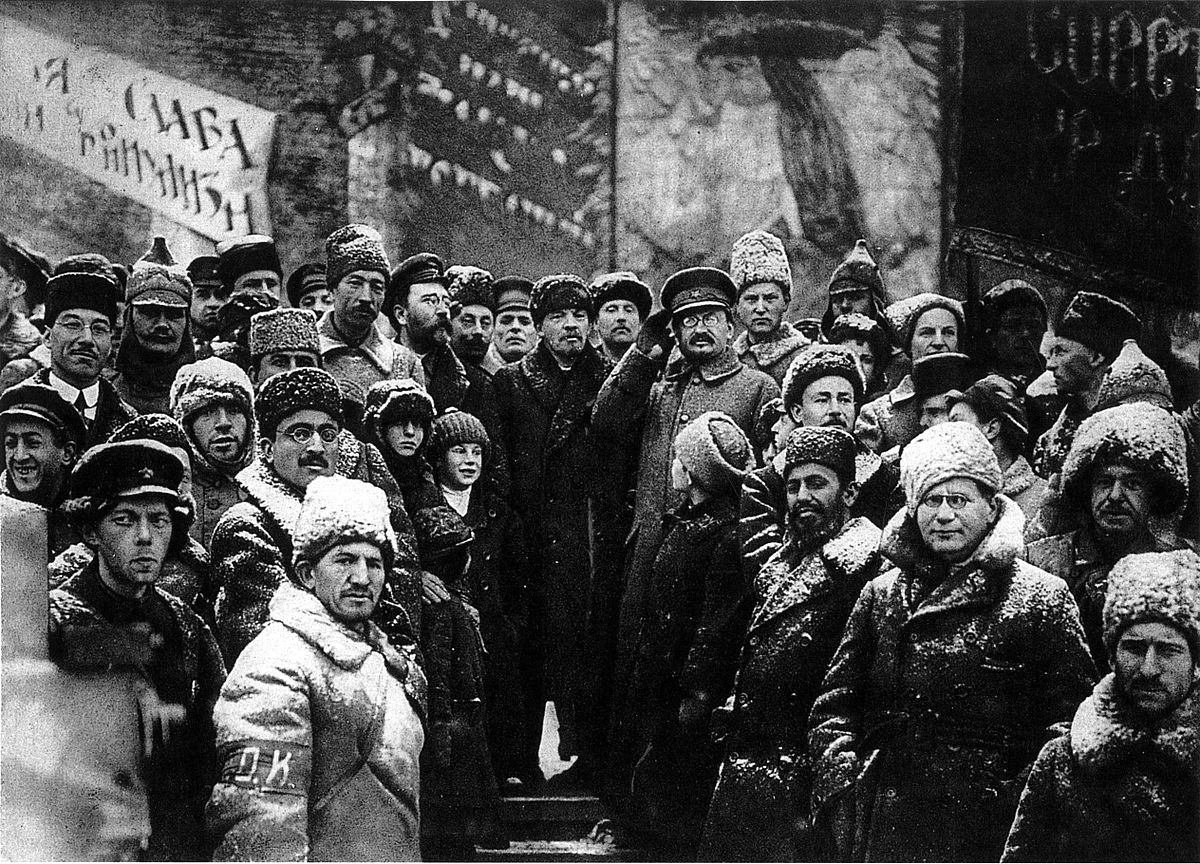A feature appeared recently in the London Evening Standard (10th February, 2017) by a certain Victor Sebestyen about the exhibition Russian Art 1917-1932 at the Royal Academy.
The article starts pleasantly enough. This superb exhibition, he says, “is a timely historical lesson about an era that may seem long ago, in a faraway place, but still has profound relevance for us today at a time of deep uncertainty and rapid political change throughout the world.” We could not agree more, the October Revolution is hugely relevant, especially in this centenary year.
“All kinds of historians, as well as policy wonks,” explains our author, “are attending hastily convened symposia from Washington to Warsaw with titles along the lines of ‘2017: Another Revolutionary Year?’ Some may be without the question mark.”
So far so good. But, of course, good things can come to an end, starting with the second paragraph.
Bolshevism vs Stalinism
 Mr Sebestyen soon reveals his true colours, launching into a vitriolic attack on Lenin and the Revolution, “a story of Russia’s tragic 20th century”. He says the “brave new world” (i.e. the Revolution) turned into “killing fields and gulag labour camps”. Like all liberal historians, the whole thrust of his argument is to try to identify Lenin with Stalinism and its brutal dictatorship.
Mr Sebestyen soon reveals his true colours, launching into a vitriolic attack on Lenin and the Revolution, “a story of Russia’s tragic 20th century”. He says the “brave new world” (i.e. the Revolution) turned into “killing fields and gulag labour camps”. Like all liberal historians, the whole thrust of his argument is to try to identify Lenin with Stalinism and its brutal dictatorship.
“Marxism was in essence a religious faith”, states our cheek-of-the-devil historian. Such a comment reveals his complete ignorance. Marxism is not a religion, but a science, which, unlike our bourgeois friends who praise the market economy, has explained the inevitable crisis of the capitalist system. This has been graphically confirmed by the 2008 slump and today’s ongoing crisis. Marxism is also a guide to action - namely changing society.
“The Russian Revolution”, states Sebestyen, “was not the first to be betrayed by its own leaders and probably will not be the last.” But the Bolshevik leaders did not betray the revolution. It was the upstart Stalin, basing himself on the growing bureaucratic counter-revolution, that betrayed the revolution. All the old Bolsheviks were murdered in Stalin’s Purge Trials. This demonstrates in practice the river of blood between Stalinism and Bolshevism.
Of course, our bourgeois historian surely knows all this, but he has become very accomplished at distorting history for his own ends. “It remains an enduring myth on the Left that Lenin was essentially decent and wanted to do good but the revolution was hijacked by a brutal tyrant and madman, Stalin. It may be comforting but untrue”, says our straight-faced author. “It was Lenin who built a system based on the idea that political terror against opponents was justified for the greater end. It was perfected by Stalin but the ideas were Lenin’s.”
The Red Terror
This black propaganda – fake news - against Lenin is nothing new. Sebestyen is simply churning out the garbage of the past against the October Revolution. It is blindingly obvious that responsibility for the terror during the civil war does not lie with the Bolsheviks, but with imperialist intervention. The Bolsheviks wanted to defend the gains of the Revolution, which had put power into the hands of the working class and swept away the rule of the landlords and capitalists, while the counter-revolution wanted to violently restore the power of the old ruling classes and their system of brutal exploitation.
Twenty-one armies invaded Russia in order to destroy the rule of the workers and re-introduce a dictatorship. Why shouldn’t the workers and peasants defend themselves? What else were they supposed to do? The Red Terror constituted measures of defence against the White Terror and the forces of the counter-revolution, as with the Jacobins in the French Revolution. The only reason why opposition parties were eventually banned in Russia was not about creating a one-party state, but because these parties openly supported the counter-revolution with arms in hand. Initially, all parties were legal, except for the fascist Black Hundreds. As soon as they began supporting the White Armies and the imperialist intervention, everything changed. They became a “fifth column” and the Bolsheviks had no alternative but to ban them, in the same way as the British government banned Oswald Mosley’s British Union of Fascist during the Second World War. In 1921, factions were banned inside the Bolshevik Party as an emergency measure because of the dangers of a split. It was intended as a temporary measure until this danger had passed. Within a year, despite the ban, Lenin was proposing to organise a faction with Trotsky against Stalin and the growing bureaucracy. Unfortunately, Lenin was laid low with a series of strokes that ended his life.
“The worst of his [Lenin’s] evils was to have left a man such as Stalin in a position to lead Russia after him. That was a historic crime”, says shallow Victor. But this is a blatant fabrication. The truth is that Lenin broke off all personal relations with Stalin in early 1923 and demanded his removal as general secretary. This advice was contained in his Testament, but this was suppressed by Stalin and his supporters. Of course, our author is completely silent about this “crime”.
After Lenin’s death, Trotsky took up Lenin’s struggle against Stalinism and his anti-Marxist theory of “socialism in one country”. Unfortunately, the international defeats of the working class, largely the responsibility of Stalin and his allies, strengthened the grip of the bureaucracy. The weary Russian working class, exhausted by years of sacrifice, were elbowed aside. Stalin became the figurehead of a veracious bureaucracy. On the basis of this counter-revolution, Stalin manoeuvred to expel Trotsky, as head of the Left Opposition, then banish and murder him. This was part of a political counter-revolution against the October Revolution. On this basis, Stalin set up a monstrous bureaucratic dictatorship, which had nothing in common with the democratic regime of Lenin and Trotsky.
Of course, the danger of telling the truth about the Bolshevik Revolution would simply serve to legitimise the ideas of Lenin and Trotsky. This, the apologists of capitalism cannot do. They have another job. For them, the real ideals of October must be slandered and buried, so as not to provide an example for today’s workers and youth who are facing the brunt of capitalist crisis.
Support for the Soviets
“The dreaded hand of the leader of the Russian Revolution, Vladimir Illyich Lenin, is ever-present in the exhibition”, frets our learned sage. The description of Lenin’s influence as “dreaded” simply reveals our liberal’s dread of the Revolution, which he personifies in Lenin.
Again, our liberal historian tries his best to picture Lenin as some kind of bloodthirsty fanatic, by falsely putting words in Lenin’s mouth to his fellow “conspirators”: “Do you think we can do this without firing squads?” This is simply a fairy tale, an invention, despite the assertions of our “unbiased” historian.
“There was repression from the start, a civil war that cost at least three million lives”, he states, which again is a complete distortion. To begin with, “from the start” the Revolution was very peaceful because there was nobody prepared to stand up and support the unpopular Provisional Government. Only five people lost their lives in Petrograd during the insurrection, and a few hundred in Moscow, while, in contrast, millions perished in the imperialist world war. The Russian civil war led to the death of millions, but this was down to the imperialist intervention and blockade against Russia.
The support for the Soviet government was admitted by General Gough, a leader of the interventionist forces, who recognised that, “the Russians are determined to prevent the return to power of the old official classes, and if forced to a choice, which is what is actually happening at the moment, they prefer the Bolshevik government.”
Dangerous times
Mr Sebestyen has a new book out, called Lenin the Dictator: An Intimate Portrait. Having read his rubbish in the Evening Standard, I wouldn’t recommend anyone wasting their time on another poisonous fabrication of poor old Lenin.
Nevertheless, it is worth quoting his article’s penultimate paragraph. “If in 2017 we are at a revolutionary moment, as many serious thinkers believe in the age of Trump and the new populism, it would not be far-fetched to see the Royal Academy show as a timely warning of dangerous times to come.”
This is meant as a serious warning to the powers that be. For us, however, it is recognition of our Marxist analysis that a new revolution is entirely possible and necessary.
